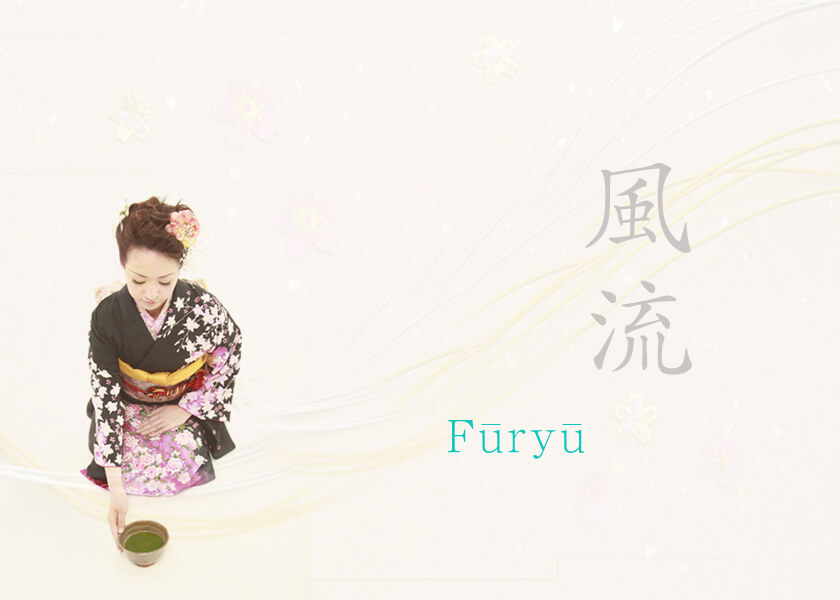Lesson
News / Blog
Other Menus
Fūryū

Fūryū
“Fūryū” is one of the aesthetic values that became popular after the Middle Ages in Japan. It means gorgeous, elaborate designs intended to surprise other people and was recognized together with “Basara” and “Suki” as the opposite of “Wabi” and “Sabi” (plain and quiet tastes). Later, it also came to mean performing arts, art objects and architecture which were in tune with the spirit of Fūryū. In the “Kagakushu” of the Muromachi period, it was written that, “Fūryū means popular things in Japan.” The meaning of the word in those days was slightly different from the modern one.
In the “Manyōshū,” it was given the Japanese reading “Miyabi” and held the additional meaning of “a curious mind”; in the Heian period, it meant historical events which were quoted in “Utaawase” (events where poems were written and read by two competing groups) or other events, objects or clothes from literature. After the end of the Heian Period, festival floats and clothes and the elaborate designs of the theater Suhamadai (standing trays with sandbar patterns) were called “Fūryū.” People who held such tastes were called “Fūryūza.” On the other hand, the original form of the “Fūryū” which was remembered by future generations as “to keep rhythm with music and songs” is recorded in events such as the 1096 Eicho Daidengaku, in which people from the aristocrats and government bureaucrats down to the common people wore Fūryū-style costumes and marched while playing Dengaku (a Japanese traditional performing art), and a festival of souls at Imamiya-jinja Shrine (in Kyoto City) in 1154, where a “Pleasure of Fūryū” was held, in which people held umbrellas decorated with Fūryū-style flowers and sang songs. After the period of the Northern and Southern Courts (Japan) in particular, powerful leaders like “Machishuu” (rich merchants) in the urban areas and “Otona” (leaders of farmer’s organizations) in the rural areas appeared, and “Fūryū” was included in the festivals and performing arts that they hosted. In the same period, people appeared as well as things: the “Hayashimono” who marched with flutes and drums and wore gorgeous clothes, the “Hyoshimono” who accompanied the Hayashimono and beat time for them, and the “Fūryū-odori” who danced in a group. From the late Sengoku period to the early Edo period, the government also showed favorable attitudes towards Fūryū, and in 1604, on the seventh anniversary of the death of Hideyoshi TOYOTOMI, the commerce and industry people of Kyoto held a big Fūryū-odori with support from the TOYOTOMI family. This “Fūryū” trend affected the temple performing arts of the same period, such as “Sarugaku,” “Noh” and “Kyōgen.” In “Shikisanban,” one of the three elements of “Nohgaku” (together with Nou and Kyōgen) was called “Fūryū,” and meant to perform while singing, dressed in gaudy clothes; it was used as an important element of direction, and was also adopted by Kyōgen direction. In 1660, Toraaki OKURA wrote a book called “Fūryū no Hon (The Book of Fūryū),” in which he recorded thirty Fūryū plays, but many of them are not performed anymore. The styles, performances, and sensations of Fūryū affected “Kabuki” and “Bunraku,” which were established in the Edo period, the architecture of the Azuchi-Momoyama period, and Genroku culture. Its connection with the “Bon” dance, Buddhist invocations, and New Year’s decorations today have also been pointed out.
Fūryū means “a refined, tasteful or elegant atmosphere” in Japan today.

Reference Book
 |
|
Zen and Japanese Culture (English Edition) 新品価格 |
![]()

